Strategic Change Management: Analysis and Recommendations for FP Plc
VerifiedAdded on 2020/01/15
|10
|2591
|189
Report
AI Summary
This report examines strategic change management within the context of Framlington Property Plc, a UK-based property developer aiming to expand into emerging markets. It begins with an introduction to strategic change management, emphasizing the importance of minimizing negative impacts during organizational transitions. The report then delves into stakeholder analysis, identifying key stakeholders and their influence, followed by the development of change management strategies involving stakeholders, including forming teams and engaging with creditors like HSBC. It evaluates systems for planning change, utilizing stakeholder circle methodology to identify, prioritize, and engage stakeholders. Furthermore, the report addresses strategies for overcoming resistance to change, emphasizing employee involvement and direct vs. indirect resistance. The analysis incorporates strategic change management models like the Kurt-Lewin model, gap analysis, and action research, with implementation strategies involving delayering, downsizing, and contingency planning. Finally, it explores appropriate measures to monitor progress, including outcome-based evaluation and regular performance reports, providing a comprehensive overview of strategic change management principles and their practical application.
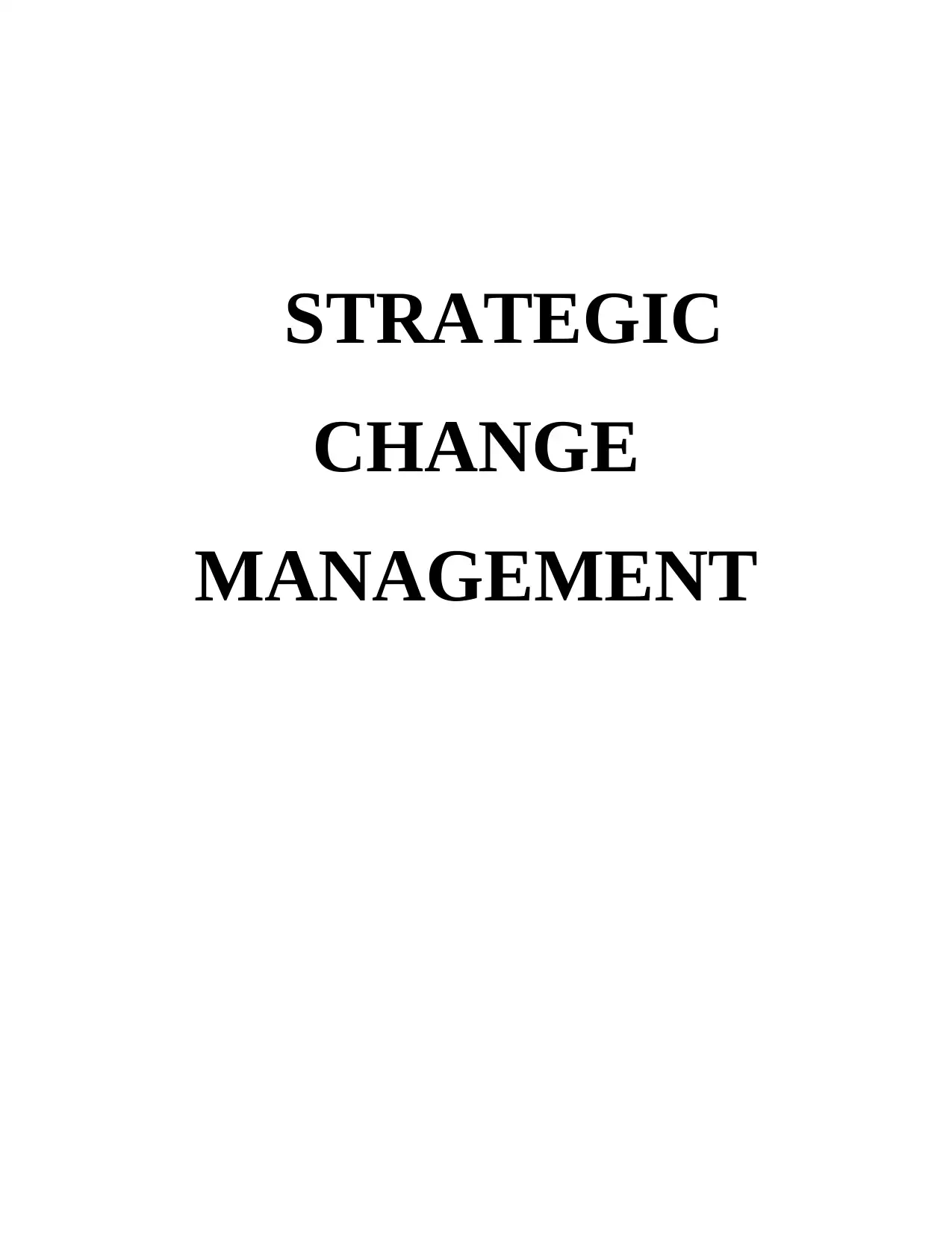
STRATEGIC
CHANGE
MANAGEMENT
CHANGE
MANAGEMENT
Paraphrase This Document
Need a fresh take? Get an instant paraphrase of this document with our AI Paraphraser
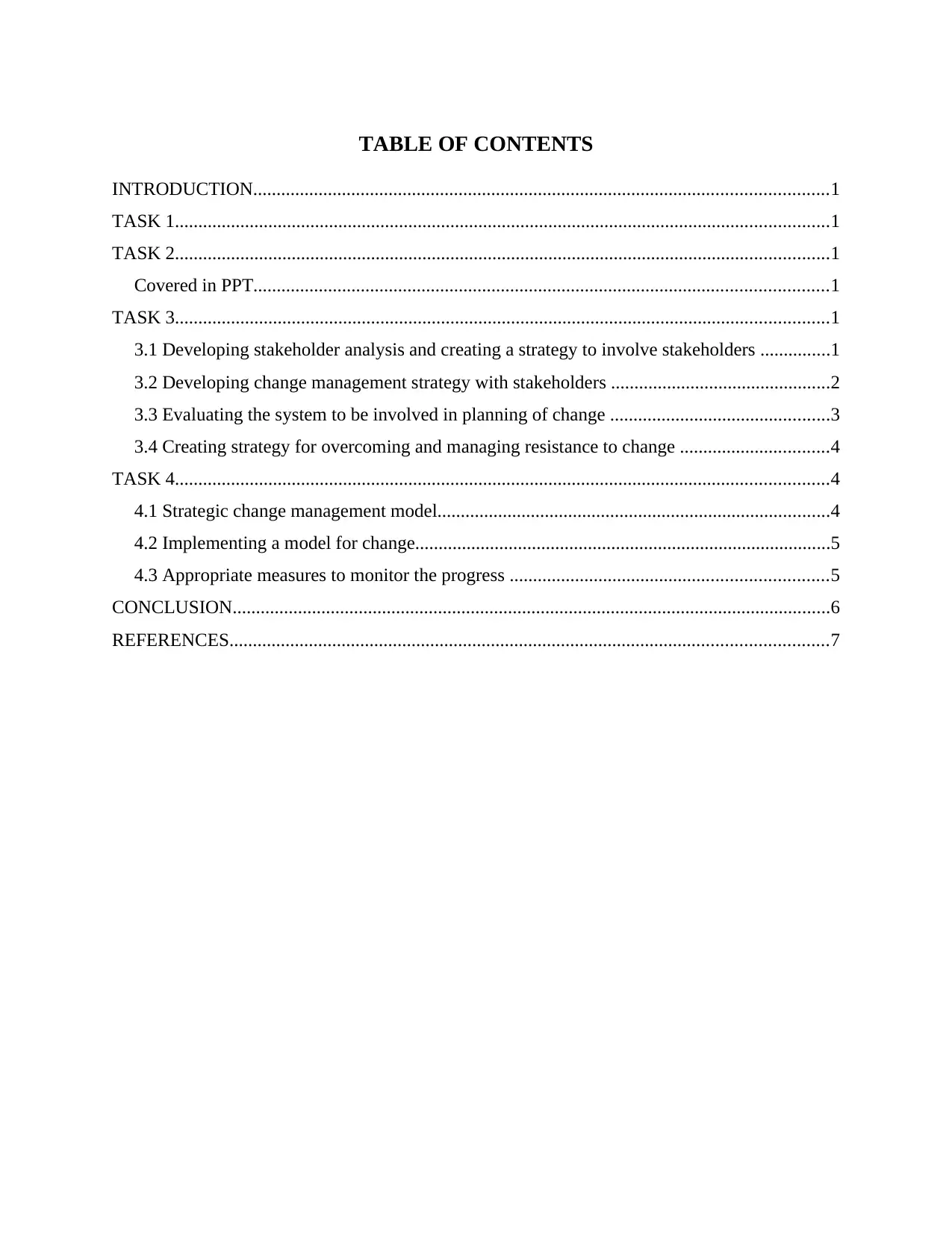
TABLE OF CONTENTS
INTRODUCTION...........................................................................................................................1
TASK 1............................................................................................................................................1
TASK 2............................................................................................................................................1
Covered in PPT...........................................................................................................................1
TASK 3............................................................................................................................................1
3.1 Developing stakeholder analysis and creating a strategy to involve stakeholders ...............1
3.2 Developing change management strategy with stakeholders ...............................................2
3.3 Evaluating the system to be involved in planning of change ...............................................3
3.4 Creating strategy for overcoming and managing resistance to change ................................4
TASK 4............................................................................................................................................4
4.1 Strategic change management model....................................................................................4
4.2 Implementing a model for change.........................................................................................5
4.3 Appropriate measures to monitor the progress ....................................................................5
CONCLUSION................................................................................................................................6
REFERENCES................................................................................................................................7
INTRODUCTION...........................................................................................................................1
TASK 1............................................................................................................................................1
TASK 2............................................................................................................................................1
Covered in PPT...........................................................................................................................1
TASK 3............................................................................................................................................1
3.1 Developing stakeholder analysis and creating a strategy to involve stakeholders ...............1
3.2 Developing change management strategy with stakeholders ...............................................2
3.3 Evaluating the system to be involved in planning of change ...............................................3
3.4 Creating strategy for overcoming and managing resistance to change ................................4
TASK 4............................................................................................................................................4
4.1 Strategic change management model....................................................................................4
4.2 Implementing a model for change.........................................................................................5
4.3 Appropriate measures to monitor the progress ....................................................................5
CONCLUSION................................................................................................................................6
REFERENCES................................................................................................................................7
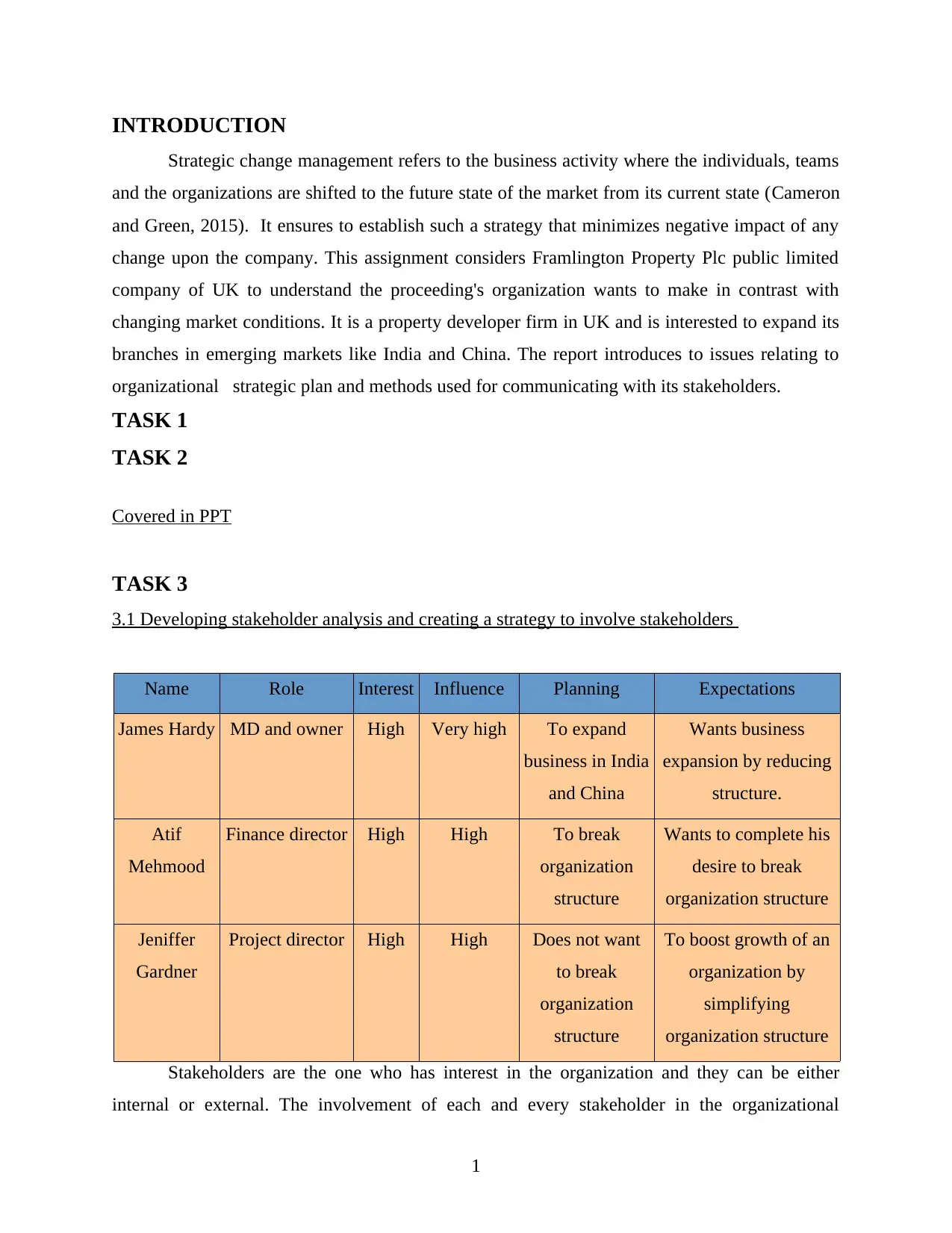
INTRODUCTION
Strategic change management refers to the business activity where the individuals, teams
and the organizations are shifted to the future state of the market from its current state (Cameron
and Green, 2015). It ensures to establish such a strategy that minimizes negative impact of any
change upon the company. This assignment considers Framlington Property Plc public limited
company of UK to understand the proceeding's organization wants to make in contrast with
changing market conditions. It is a property developer firm in UK and is interested to expand its
branches in emerging markets like India and China. The report introduces to issues relating to
organizational strategic plan and methods used for communicating with its stakeholders.
TASK 1
TASK 2
Covered in PPT
TASK 3
3.1 Developing stakeholder analysis and creating a strategy to involve stakeholders
Name Role Interest Influence Planning Expectations
James Hardy MD and owner High Very high To expand
business in India
and China
Wants business
expansion by reducing
structure.
Atif
Mehmood
Finance director High High To break
organization
structure
Wants to complete his
desire to break
organization structure
Jeniffer
Gardner
Project director High High Does not want
to break
organization
structure
To boost growth of an
organization by
simplifying
organization structure
Stakeholders are the one who has interest in the organization and they can be either
internal or external. The involvement of each and every stakeholder in the organizational
1
Strategic change management refers to the business activity where the individuals, teams
and the organizations are shifted to the future state of the market from its current state (Cameron
and Green, 2015). It ensures to establish such a strategy that minimizes negative impact of any
change upon the company. This assignment considers Framlington Property Plc public limited
company of UK to understand the proceeding's organization wants to make in contrast with
changing market conditions. It is a property developer firm in UK and is interested to expand its
branches in emerging markets like India and China. The report introduces to issues relating to
organizational strategic plan and methods used for communicating with its stakeholders.
TASK 1
TASK 2
Covered in PPT
TASK 3
3.1 Developing stakeholder analysis and creating a strategy to involve stakeholders
Name Role Interest Influence Planning Expectations
James Hardy MD and owner High Very high To expand
business in India
and China
Wants business
expansion by reducing
structure.
Atif
Mehmood
Finance director High High To break
organization
structure
Wants to complete his
desire to break
organization structure
Jeniffer
Gardner
Project director High High Does not want
to break
organization
structure
To boost growth of an
organization by
simplifying
organization structure
Stakeholders are the one who has interest in the organization and they can be either
internal or external. The involvement of each and every stakeholder in the organizational
1
⊘ This is a preview!⊘
Do you want full access?
Subscribe today to unlock all pages.

Trusted by 1+ million students worldwide
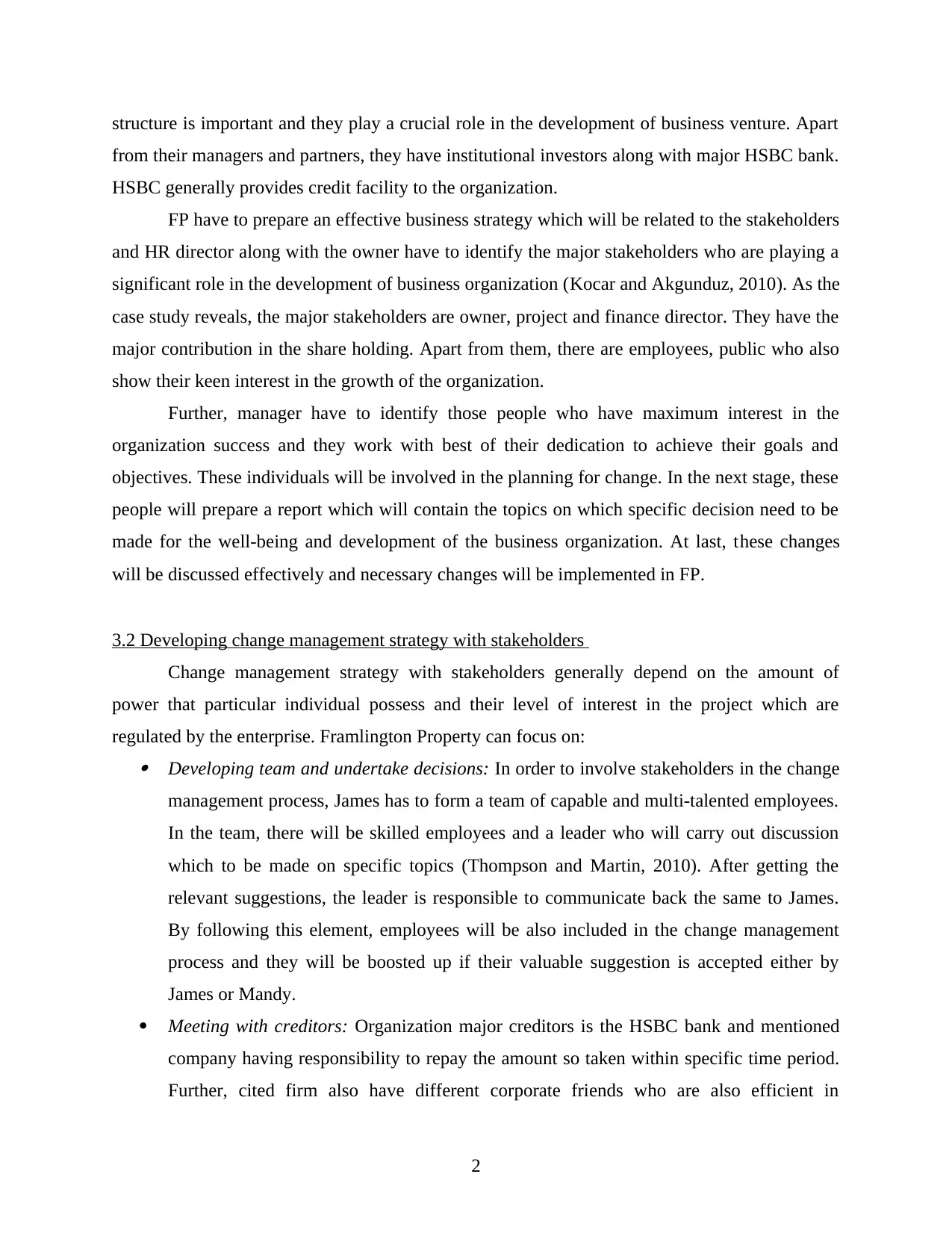
structure is important and they play a crucial role in the development of business venture. Apart
from their managers and partners, they have institutional investors along with major HSBC bank.
HSBC generally provides credit facility to the organization.
FP have to prepare an effective business strategy which will be related to the stakeholders
and HR director along with the owner have to identify the major stakeholders who are playing a
significant role in the development of business organization (Kocar and Akgunduz, 2010). As the
case study reveals, the major stakeholders are owner, project and finance director. They have the
major contribution in the share holding. Apart from them, there are employees, public who also
show their keen interest in the growth of the organization.
Further, manager have to identify those people who have maximum interest in the
organization success and they work with best of their dedication to achieve their goals and
objectives. These individuals will be involved in the planning for change. In the next stage, these
people will prepare a report which will contain the topics on which specific decision need to be
made for the well-being and development of the business organization. At last, these changes
will be discussed effectively and necessary changes will be implemented in FP.
3.2 Developing change management strategy with stakeholders
Change management strategy with stakeholders generally depend on the amount of
power that particular individual possess and their level of interest in the project which are
regulated by the enterprise. Framlington Property can focus on: Developing team and undertake decisions: In order to involve stakeholders in the change
management process, James has to form a team of capable and multi-talented employees.
In the team, there will be skilled employees and a leader who will carry out discussion
which to be made on specific topics (Thompson and Martin, 2010). After getting the
relevant suggestions, the leader is responsible to communicate back the same to James.
By following this element, employees will be also included in the change management
process and they will be boosted up if their valuable suggestion is accepted either by
James or Mandy.
Meeting with creditors: Organization major creditors is the HSBC bank and mentioned
company having responsibility to repay the amount so taken within specific time period.
Further, cited firm also have different corporate friends who are also efficient in
2
from their managers and partners, they have institutional investors along with major HSBC bank.
HSBC generally provides credit facility to the organization.
FP have to prepare an effective business strategy which will be related to the stakeholders
and HR director along with the owner have to identify the major stakeholders who are playing a
significant role in the development of business organization (Kocar and Akgunduz, 2010). As the
case study reveals, the major stakeholders are owner, project and finance director. They have the
major contribution in the share holding. Apart from them, there are employees, public who also
show their keen interest in the growth of the organization.
Further, manager have to identify those people who have maximum interest in the
organization success and they work with best of their dedication to achieve their goals and
objectives. These individuals will be involved in the planning for change. In the next stage, these
people will prepare a report which will contain the topics on which specific decision need to be
made for the well-being and development of the business organization. At last, these changes
will be discussed effectively and necessary changes will be implemented in FP.
3.2 Developing change management strategy with stakeholders
Change management strategy with stakeholders generally depend on the amount of
power that particular individual possess and their level of interest in the project which are
regulated by the enterprise. Framlington Property can focus on: Developing team and undertake decisions: In order to involve stakeholders in the change
management process, James has to form a team of capable and multi-talented employees.
In the team, there will be skilled employees and a leader who will carry out discussion
which to be made on specific topics (Thompson and Martin, 2010). After getting the
relevant suggestions, the leader is responsible to communicate back the same to James.
By following this element, employees will be also included in the change management
process and they will be boosted up if their valuable suggestion is accepted either by
James or Mandy.
Meeting with creditors: Organization major creditors is the HSBC bank and mentioned
company having responsibility to repay the amount so taken within specific time period.
Further, cited firm also have different corporate friends who are also efficient in
2
Paraphrase This Document
Need a fresh take? Get an instant paraphrase of this document with our AI Paraphraser
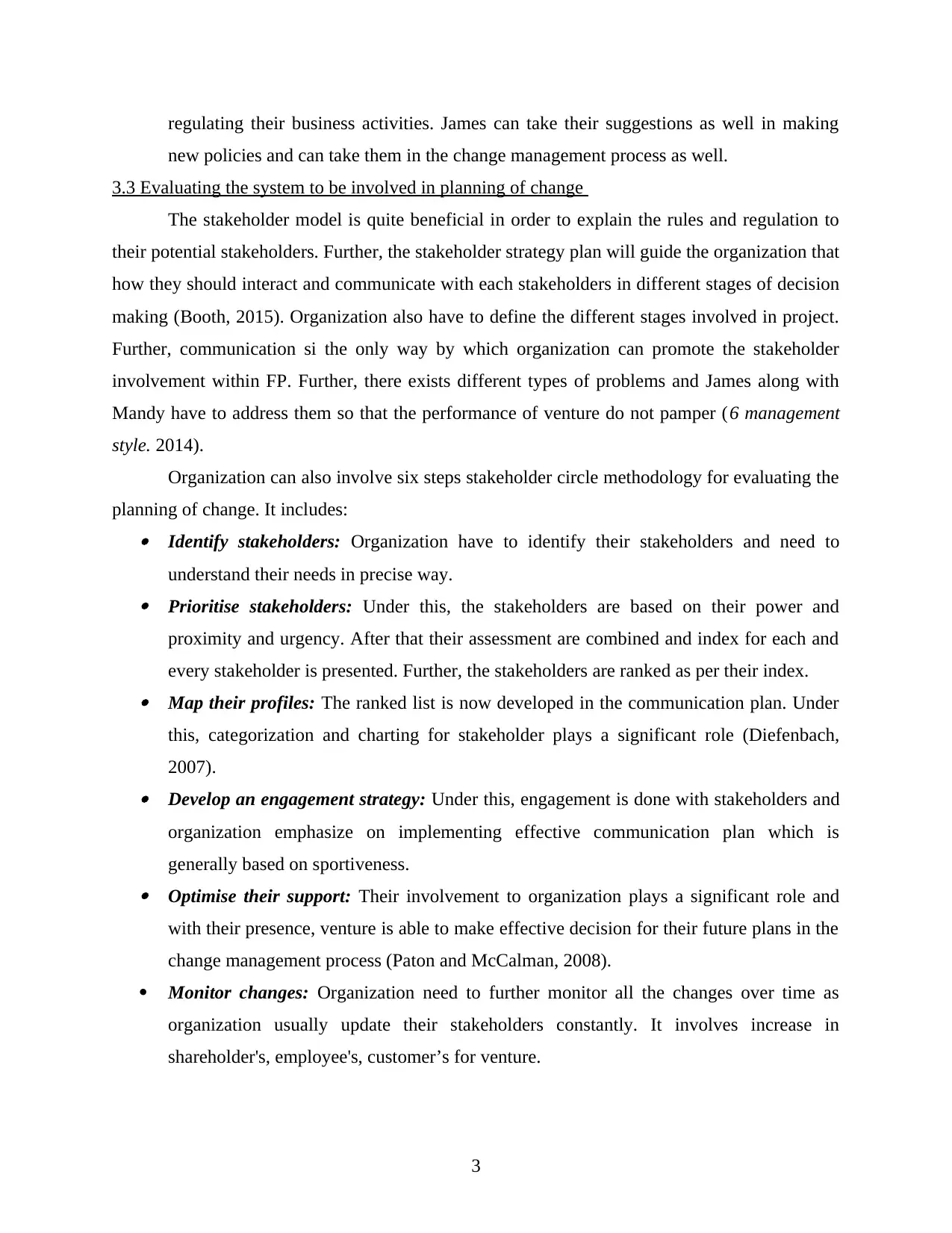
regulating their business activities. James can take their suggestions as well in making
new policies and can take them in the change management process as well.
3.3 Evaluating the system to be involved in planning of change
The stakeholder model is quite beneficial in order to explain the rules and regulation to
their potential stakeholders. Further, the stakeholder strategy plan will guide the organization that
how they should interact and communicate with each stakeholders in different stages of decision
making (Booth, 2015). Organization also have to define the different stages involved in project.
Further, communication si the only way by which organization can promote the stakeholder
involvement within FP. Further, there exists different types of problems and James along with
Mandy have to address them so that the performance of venture do not pamper (6 management
style. 2014).
Organization can also involve six steps stakeholder circle methodology for evaluating the
planning of change. It includes: Identify stakeholders: Organization have to identify their stakeholders and need to
understand their needs in precise way. Prioritise stakeholders: Under this, the stakeholders are based on their power and
proximity and urgency. After that their assessment are combined and index for each and
every stakeholder is presented. Further, the stakeholders are ranked as per their index. Map their profiles: The ranked list is now developed in the communication plan. Under
this, categorization and charting for stakeholder plays a significant role (Diefenbach,
2007). Develop an engagement strategy: Under this, engagement is done with stakeholders and
organization emphasize on implementing effective communication plan which is
generally based on sportiveness. Optimise their support: Their involvement to organization plays a significant role and
with their presence, venture is able to make effective decision for their future plans in the
change management process (Paton and McCalman, 2008).
Monitor changes: Organization need to further monitor all the changes over time as
organization usually update their stakeholders constantly. It involves increase in
shareholder's, employee's, customer’s for venture.
3
new policies and can take them in the change management process as well.
3.3 Evaluating the system to be involved in planning of change
The stakeholder model is quite beneficial in order to explain the rules and regulation to
their potential stakeholders. Further, the stakeholder strategy plan will guide the organization that
how they should interact and communicate with each stakeholders in different stages of decision
making (Booth, 2015). Organization also have to define the different stages involved in project.
Further, communication si the only way by which organization can promote the stakeholder
involvement within FP. Further, there exists different types of problems and James along with
Mandy have to address them so that the performance of venture do not pamper (6 management
style. 2014).
Organization can also involve six steps stakeholder circle methodology for evaluating the
planning of change. It includes: Identify stakeholders: Organization have to identify their stakeholders and need to
understand their needs in precise way. Prioritise stakeholders: Under this, the stakeholders are based on their power and
proximity and urgency. After that their assessment are combined and index for each and
every stakeholder is presented. Further, the stakeholders are ranked as per their index. Map their profiles: The ranked list is now developed in the communication plan. Under
this, categorization and charting for stakeholder plays a significant role (Diefenbach,
2007). Develop an engagement strategy: Under this, engagement is done with stakeholders and
organization emphasize on implementing effective communication plan which is
generally based on sportiveness. Optimise their support: Their involvement to organization plays a significant role and
with their presence, venture is able to make effective decision for their future plans in the
change management process (Paton and McCalman, 2008).
Monitor changes: Organization need to further monitor all the changes over time as
organization usually update their stakeholders constantly. It involves increase in
shareholder's, employee's, customer’s for venture.
3
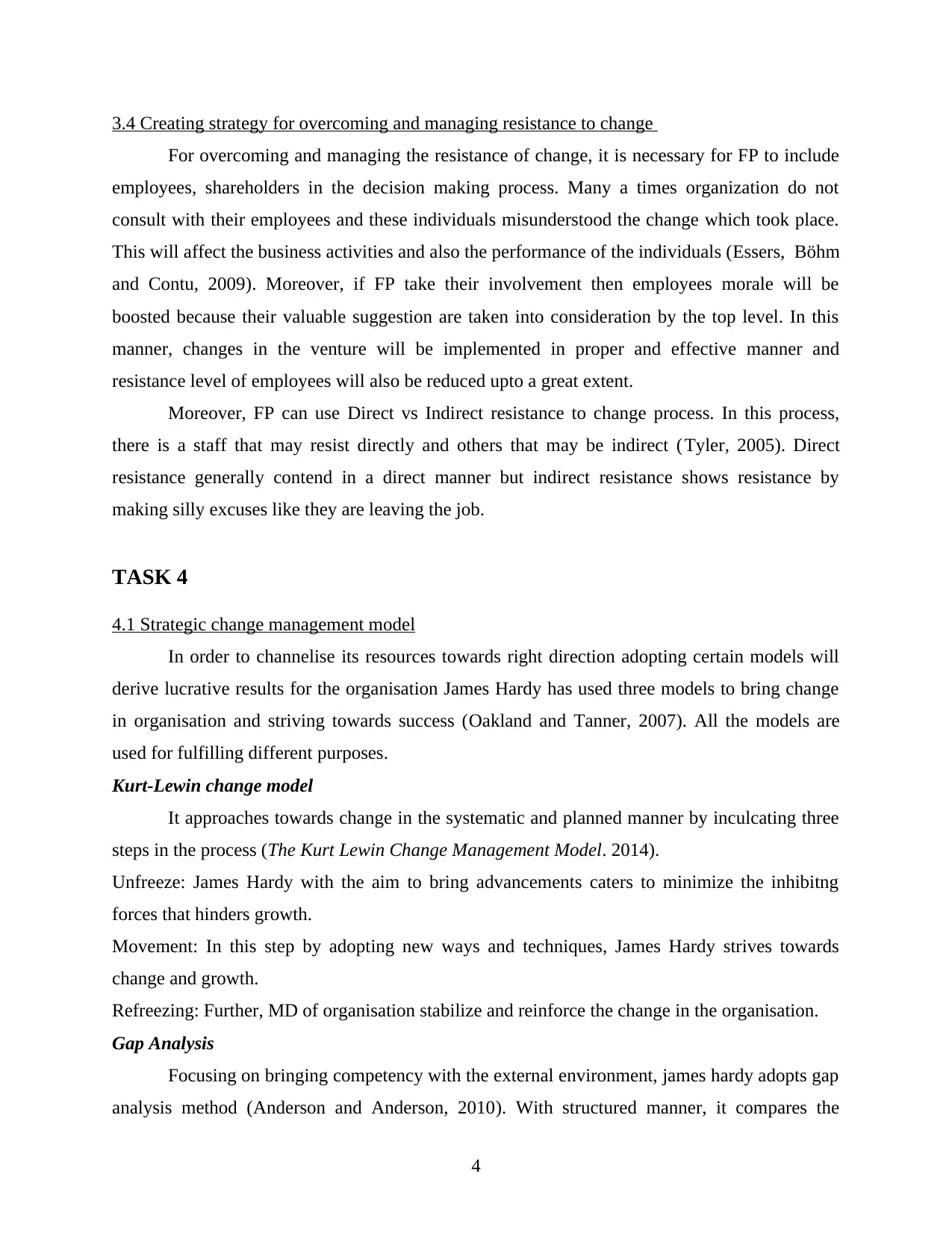
3.4 Creating strategy for overcoming and managing resistance to change
For overcoming and managing the resistance of change, it is necessary for FP to include
employees, shareholders in the decision making process. Many a times organization do not
consult with their employees and these individuals misunderstood the change which took place.
This will affect the business activities and also the performance of the individuals (Essers, Böhm
and Contu, 2009). Moreover, if FP take their involvement then employees morale will be
boosted because their valuable suggestion are taken into consideration by the top level. In this
manner, changes in the venture will be implemented in proper and effective manner and
resistance level of employees will also be reduced upto a great extent.
Moreover, FP can use Direct vs Indirect resistance to change process. In this process,
there is a staff that may resist directly and others that may be indirect (Tyler, 2005). Direct
resistance generally contend in a direct manner but indirect resistance shows resistance by
making silly excuses like they are leaving the job.
TASK 4
4.1 Strategic change management model
In order to channelise its resources towards right direction adopting certain models will
derive lucrative results for the organisation James Hardy has used three models to bring change
in organisation and striving towards success (Oakland and Tanner, 2007). All the models are
used for fulfilling different purposes.
Kurt-Lewin change model
It approaches towards change in the systematic and planned manner by inculcating three
steps in the process (The Kurt Lewin Change Management Model. 2014).
Unfreeze: James Hardy with the aim to bring advancements caters to minimize the inhibitng
forces that hinders growth.
Movement: In this step by adopting new ways and techniques, James Hardy strives towards
change and growth.
Refreezing: Further, MD of organisation stabilize and reinforce the change in the organisation.
Gap Analysis
Focusing on bringing competency with the external environment, james hardy adopts gap
analysis method (Anderson and Anderson, 2010). With structured manner, it compares the
4
For overcoming and managing the resistance of change, it is necessary for FP to include
employees, shareholders in the decision making process. Many a times organization do not
consult with their employees and these individuals misunderstood the change which took place.
This will affect the business activities and also the performance of the individuals (Essers, Böhm
and Contu, 2009). Moreover, if FP take their involvement then employees morale will be
boosted because their valuable suggestion are taken into consideration by the top level. In this
manner, changes in the venture will be implemented in proper and effective manner and
resistance level of employees will also be reduced upto a great extent.
Moreover, FP can use Direct vs Indirect resistance to change process. In this process,
there is a staff that may resist directly and others that may be indirect (Tyler, 2005). Direct
resistance generally contend in a direct manner but indirect resistance shows resistance by
making silly excuses like they are leaving the job.
TASK 4
4.1 Strategic change management model
In order to channelise its resources towards right direction adopting certain models will
derive lucrative results for the organisation James Hardy has used three models to bring change
in organisation and striving towards success (Oakland and Tanner, 2007). All the models are
used for fulfilling different purposes.
Kurt-Lewin change model
It approaches towards change in the systematic and planned manner by inculcating three
steps in the process (The Kurt Lewin Change Management Model. 2014).
Unfreeze: James Hardy with the aim to bring advancements caters to minimize the inhibitng
forces that hinders growth.
Movement: In this step by adopting new ways and techniques, James Hardy strives towards
change and growth.
Refreezing: Further, MD of organisation stabilize and reinforce the change in the organisation.
Gap Analysis
Focusing on bringing competency with the external environment, james hardy adopts gap
analysis method (Anderson and Anderson, 2010). With structured manner, it compares the
4
⊘ This is a preview!⊘
Do you want full access?
Subscribe today to unlock all pages.

Trusted by 1+ million students worldwide
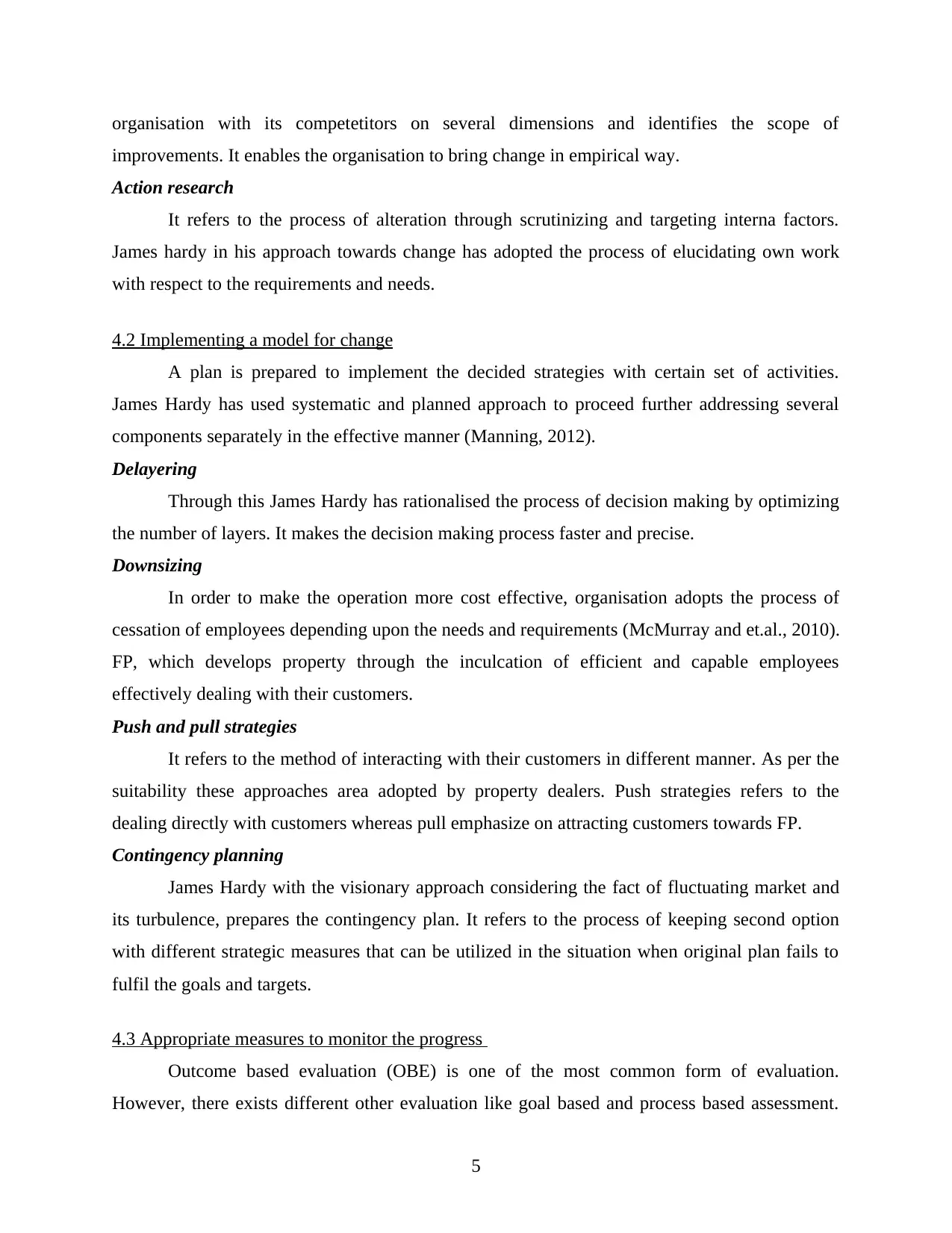
organisation with its competetitors on several dimensions and identifies the scope of
improvements. It enables the organisation to bring change in empirical way.
Action research
It refers to the process of alteration through scrutinizing and targeting interna factors.
James hardy in his approach towards change has adopted the process of elucidating own work
with respect to the requirements and needs.
4.2 Implementing a model for change
A plan is prepared to implement the decided strategies with certain set of activities.
James Hardy has used systematic and planned approach to proceed further addressing several
components separately in the effective manner (Manning, 2012).
Delayering
Through this James Hardy has rationalised the process of decision making by optimizing
the number of layers. It makes the decision making process faster and precise.
Downsizing
In order to make the operation more cost effective, organisation adopts the process of
cessation of employees depending upon the needs and requirements (McMurray and et.al., 2010).
FP, which develops property through the inculcation of efficient and capable employees
effectively dealing with their customers.
Push and pull strategies
It refers to the method of interacting with their customers in different manner. As per the
suitability these approaches area adopted by property dealers. Push strategies refers to the
dealing directly with customers whereas pull emphasize on attracting customers towards FP.
Contingency planning
James Hardy with the visionary approach considering the fact of fluctuating market and
its turbulence, prepares the contingency plan. It refers to the process of keeping second option
with different strategic measures that can be utilized in the situation when original plan fails to
fulfil the goals and targets.
4.3 Appropriate measures to monitor the progress
Outcome based evaluation (OBE) is one of the most common form of evaluation.
However, there exists different other evaluation like goal based and process based assessment.
5
improvements. It enables the organisation to bring change in empirical way.
Action research
It refers to the process of alteration through scrutinizing and targeting interna factors.
James hardy in his approach towards change has adopted the process of elucidating own work
with respect to the requirements and needs.
4.2 Implementing a model for change
A plan is prepared to implement the decided strategies with certain set of activities.
James Hardy has used systematic and planned approach to proceed further addressing several
components separately in the effective manner (Manning, 2012).
Delayering
Through this James Hardy has rationalised the process of decision making by optimizing
the number of layers. It makes the decision making process faster and precise.
Downsizing
In order to make the operation more cost effective, organisation adopts the process of
cessation of employees depending upon the needs and requirements (McMurray and et.al., 2010).
FP, which develops property through the inculcation of efficient and capable employees
effectively dealing with their customers.
Push and pull strategies
It refers to the method of interacting with their customers in different manner. As per the
suitability these approaches area adopted by property dealers. Push strategies refers to the
dealing directly with customers whereas pull emphasize on attracting customers towards FP.
Contingency planning
James Hardy with the visionary approach considering the fact of fluctuating market and
its turbulence, prepares the contingency plan. It refers to the process of keeping second option
with different strategic measures that can be utilized in the situation when original plan fails to
fulfil the goals and targets.
4.3 Appropriate measures to monitor the progress
Outcome based evaluation (OBE) is one of the most common form of evaluation.
However, there exists different other evaluation like goal based and process based assessment.
5
Paraphrase This Document
Need a fresh take? Get an instant paraphrase of this document with our AI Paraphraser
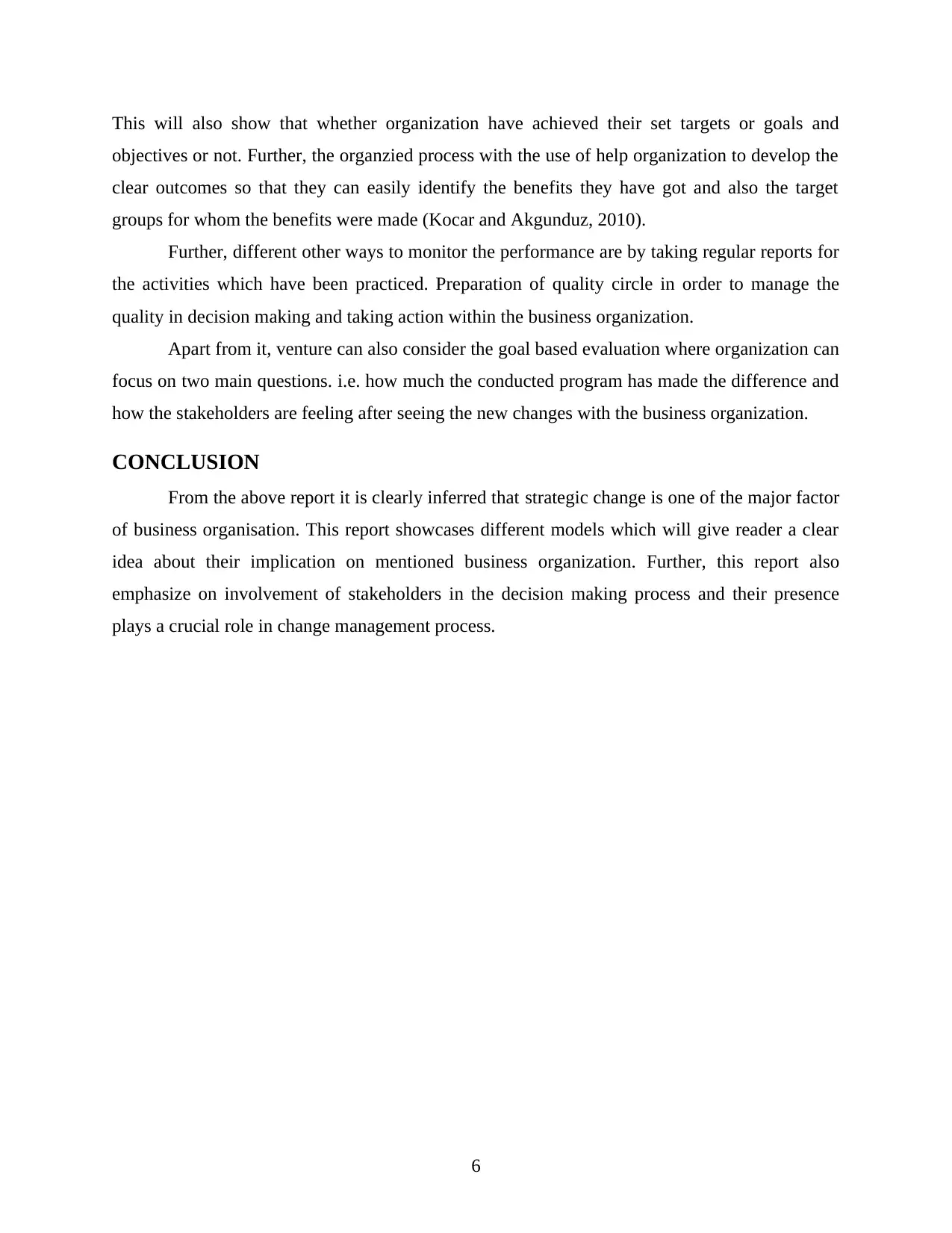
This will also show that whether organization have achieved their set targets or goals and
objectives or not. Further, the organzied process with the use of help organization to develop the
clear outcomes so that they can easily identify the benefits they have got and also the target
groups for whom the benefits were made (Kocar and Akgunduz, 2010).
Further, different other ways to monitor the performance are by taking regular reports for
the activities which have been practiced. Preparation of quality circle in order to manage the
quality in decision making and taking action within the business organization.
Apart from it, venture can also consider the goal based evaluation where organization can
focus on two main questions. i.e. how much the conducted program has made the difference and
how the stakeholders are feeling after seeing the new changes with the business organization.
CONCLUSION
From the above report it is clearly inferred that strategic change is one of the major factor
of business organisation. This report showcases different models which will give reader a clear
idea about their implication on mentioned business organization. Further, this report also
emphasize on involvement of stakeholders in the decision making process and their presence
plays a crucial role in change management process.
6
objectives or not. Further, the organzied process with the use of help organization to develop the
clear outcomes so that they can easily identify the benefits they have got and also the target
groups for whom the benefits were made (Kocar and Akgunduz, 2010).
Further, different other ways to monitor the performance are by taking regular reports for
the activities which have been practiced. Preparation of quality circle in order to manage the
quality in decision making and taking action within the business organization.
Apart from it, venture can also consider the goal based evaluation where organization can
focus on two main questions. i.e. how much the conducted program has made the difference and
how the stakeholders are feeling after seeing the new changes with the business organization.
CONCLUSION
From the above report it is clearly inferred that strategic change is one of the major factor
of business organisation. This report showcases different models which will give reader a clear
idea about their implication on mentioned business organization. Further, this report also
emphasize on involvement of stakeholders in the decision making process and their presence
plays a crucial role in change management process.
6
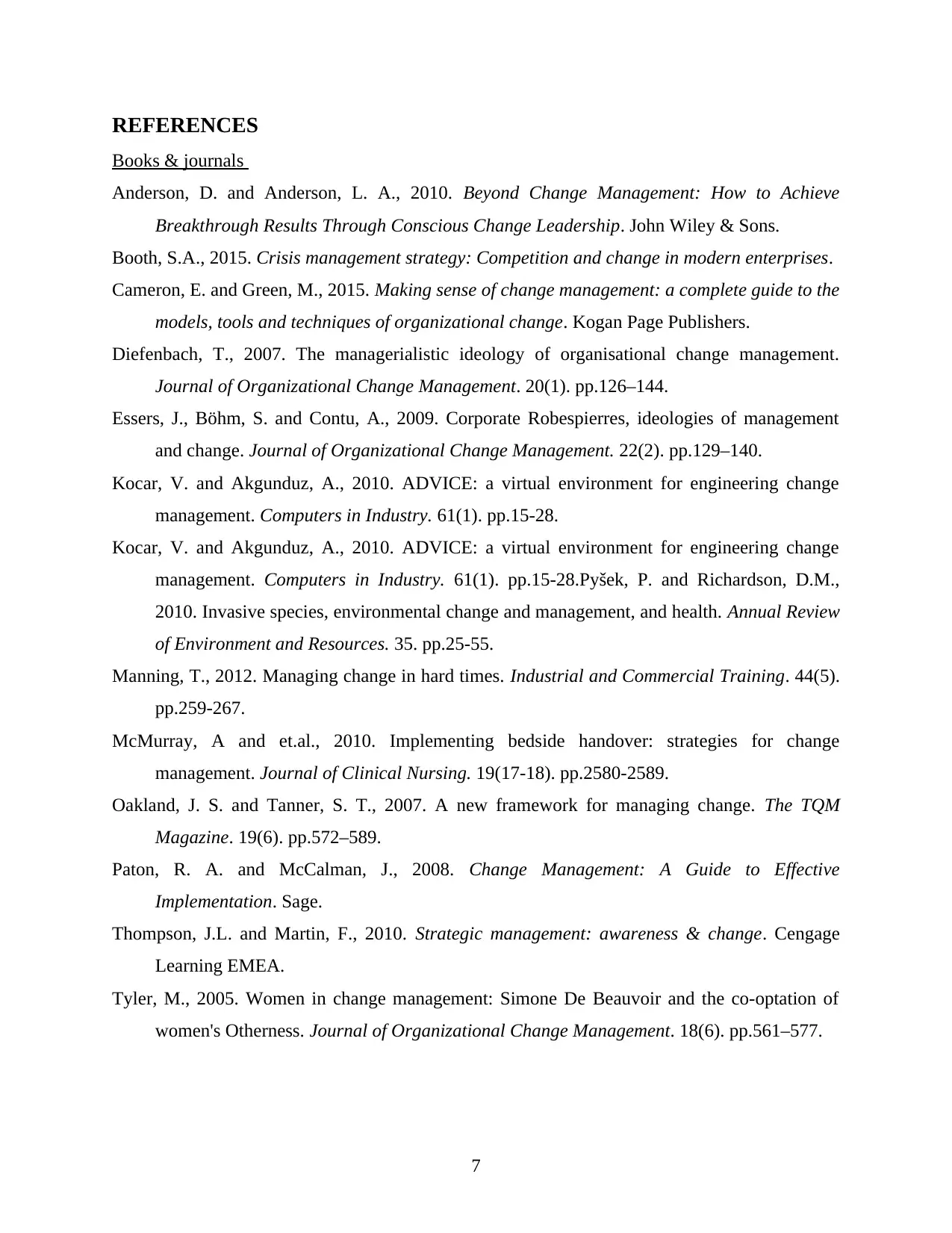
REFERENCES
Books & journals
Anderson, D. and Anderson, L. A., 2010. Beyond Change Management: How to Achieve
Breakthrough Results Through Conscious Change Leadership. John Wiley & Sons.
Booth, S.A., 2015. Crisis management strategy: Competition and change in modern enterprises.
Cameron, E. and Green, M., 2015. Making sense of change management: a complete guide to the
models, tools and techniques of organizational change. Kogan Page Publishers.
Diefenbach, T., 2007. The managerialistic ideology of organisational change management.
Journal of Organizational Change Management. 20(1). pp.126–144.
Essers, J., Böhm, S. and Contu, A., 2009. Corporate Robespierres, ideologies of management
and change. Journal of Organizational Change Management. 22(2). pp.129–140.
Kocar, V. and Akgunduz, A., 2010. ADVICE: a virtual environment for engineering change
management. Computers in Industry. 61(1). pp.15-28.
Kocar, V. and Akgunduz, A., 2010. ADVICE: a virtual environment for engineering change
management. Computers in Industry. 61(1). pp.15-28.Pyšek, P. and Richardson, D.M.,
2010. Invasive species, environmental change and management, and health. Annual Review
of Environment and Resources. 35. pp.25-55.
Manning, T., 2012. Managing change in hard times. Industrial and Commercial Training. 44(5).
pp.259-267.
McMurray, A and et.al., 2010. Implementing bedside handover: strategies for change
management. Journal of Clinical Nursing. 19(17‐18). pp.2580-2589.
Oakland, J. S. and Tanner, S. T., 2007. A new framework for managing change. The TQM
Magazine. 19(6). pp.572–589.
Paton, R. A. and McCalman, J., 2008. Change Management: A Guide to Effective
Implementation. Sage.
Thompson, J.L. and Martin, F., 2010. Strategic management: awareness & change. Cengage
Learning EMEA.
Tyler, M., 2005. Women in change management: Simone De Beauvoir and the co-optation of
women's Otherness. Journal of Organizational Change Management. 18(6). pp.561–577.
7
Books & journals
Anderson, D. and Anderson, L. A., 2010. Beyond Change Management: How to Achieve
Breakthrough Results Through Conscious Change Leadership. John Wiley & Sons.
Booth, S.A., 2015. Crisis management strategy: Competition and change in modern enterprises.
Cameron, E. and Green, M., 2015. Making sense of change management: a complete guide to the
models, tools and techniques of organizational change. Kogan Page Publishers.
Diefenbach, T., 2007. The managerialistic ideology of organisational change management.
Journal of Organizational Change Management. 20(1). pp.126–144.
Essers, J., Böhm, S. and Contu, A., 2009. Corporate Robespierres, ideologies of management
and change. Journal of Organizational Change Management. 22(2). pp.129–140.
Kocar, V. and Akgunduz, A., 2010. ADVICE: a virtual environment for engineering change
management. Computers in Industry. 61(1). pp.15-28.
Kocar, V. and Akgunduz, A., 2010. ADVICE: a virtual environment for engineering change
management. Computers in Industry. 61(1). pp.15-28.Pyšek, P. and Richardson, D.M.,
2010. Invasive species, environmental change and management, and health. Annual Review
of Environment and Resources. 35. pp.25-55.
Manning, T., 2012. Managing change in hard times. Industrial and Commercial Training. 44(5).
pp.259-267.
McMurray, A and et.al., 2010. Implementing bedside handover: strategies for change
management. Journal of Clinical Nursing. 19(17‐18). pp.2580-2589.
Oakland, J. S. and Tanner, S. T., 2007. A new framework for managing change. The TQM
Magazine. 19(6). pp.572–589.
Paton, R. A. and McCalman, J., 2008. Change Management: A Guide to Effective
Implementation. Sage.
Thompson, J.L. and Martin, F., 2010. Strategic management: awareness & change. Cengage
Learning EMEA.
Tyler, M., 2005. Women in change management: Simone De Beauvoir and the co-optation of
women's Otherness. Journal of Organizational Change Management. 18(6). pp.561–577.
7
⊘ This is a preview!⊘
Do you want full access?
Subscribe today to unlock all pages.

Trusted by 1+ million students worldwide
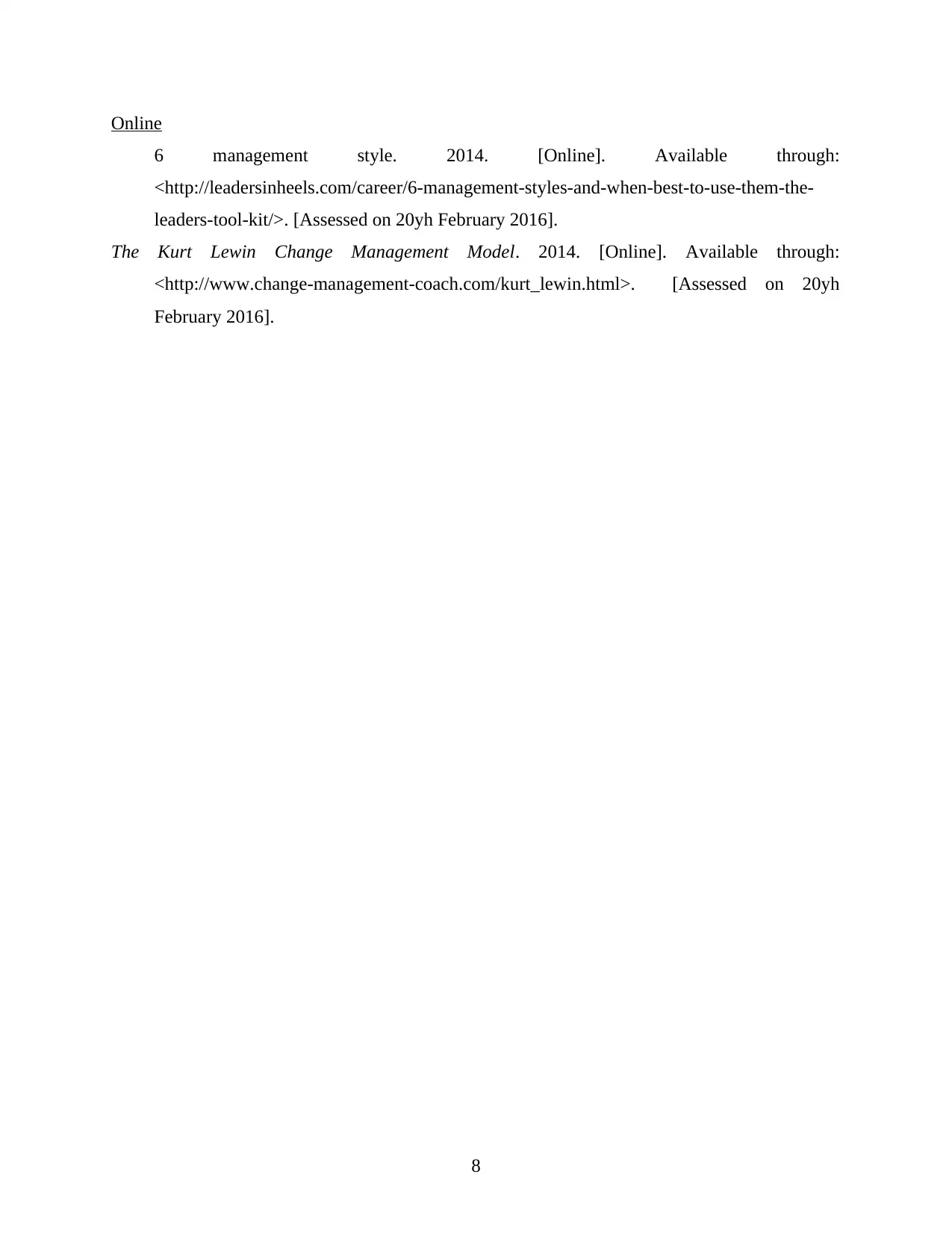
Online
6 management style. 2014. [Online]. Available through:
<http://leadersinheels.com/career/6-management-styles-and-when-best-to-use-them-the-
leaders-tool-kit/>. [Assessed on 20yh February 2016].
The Kurt Lewin Change Management Model. 2014. [Online]. Available through:
<http://www.change-management-coach.com/kurt_lewin.html>. [Assessed on 20yh
February 2016].
8
6 management style. 2014. [Online]. Available through:
<http://leadersinheels.com/career/6-management-styles-and-when-best-to-use-them-the-
leaders-tool-kit/>. [Assessed on 20yh February 2016].
The Kurt Lewin Change Management Model. 2014. [Online]. Available through:
<http://www.change-management-coach.com/kurt_lewin.html>. [Assessed on 20yh
February 2016].
8
1 out of 10
Related Documents
Your All-in-One AI-Powered Toolkit for Academic Success.
+13062052269
info@desklib.com
Available 24*7 on WhatsApp / Email
![[object Object]](/_next/static/media/star-bottom.7253800d.svg)
Unlock your academic potential
Copyright © 2020–2025 A2Z Services. All Rights Reserved. Developed and managed by ZUCOL.





